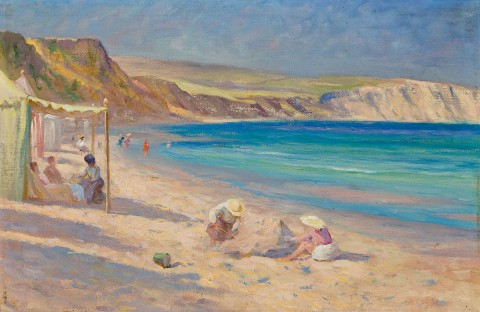OUR TENT AT SWANAGE, DORSETSHIRE, c.1903
TUDOR ST GEORGE TUCKER
oil on canvas
50.5 x 76.5 cm
bears inscription on old label verso: Our Tent At Swanage … /For Dr Wilkinson/In Remembrance Of/Tudor St G. Tucker
Captain Charlton Nassau Tucker and Mrs Harriet Tucker, United Kingdom, the artist’s parents
Dr William Cleland Wilkinson, Melbourne, a gift from the above
Thence by descent
Private collection
Sotheby’s, Melbourne, 22 November 1999, lot 35
The Cbus Collection of Australian Art, Melbourne, acquired from the above
on long term loan to Wollongong City Gallery, New South Wales
Nainby, B., Stanhope, Z., and Furlonger, K., The Cbus Collection of Australian Art, in association with Latrobe Regional Gallery, Melbourne, 2009, pp. 17 – 18, 31 (illus.), 235
We are grateful to Brenda Martin Thomas, wife of the late David Thomas AM, for kindly allowing us to reproduce David's research and writing in this catalogue entry.
When Tudor St George Tucker returned to Melbourne in 1892 after studying at the Académie Julian and the École des Beaux-Arts, he brought with him new ideas fresh from Paris and a painting technique that was much admired. His contemporaries saw his work as belonging ‘to the modern French school, whose principal tenets are an insistence on atmospheric effect, a preference for neutral colour and an absence of detail. Nature is regarded from afar off, when outline becomes indistinguishable and merges into colour.’1 Establishing the Melbourne Art School with E. Phillips Fox, together with summer schools at Charterisville, he exerted a wide influence that extended beyond the circle of his students to include established artists such as Frederick McCubbin. Moreover, the School placed an emphasis on painting en plein air, the summer term being devoted to outdoor sketching in the country or seaside, with special attention paid to colour. During this time, Tucker also became noted for his portraits, especially of young women, while his landscapes such as A Study of Sunlight, c.1892; Early Dawn, c.1893, and Springtime, c.1893 showed more than a casual Impressionist interest in nature.
Aspects of impressionism are included in Our Tent at Swanage, Dorsetshire, c.1903 in the informality of the brushwork, vivid colour, and the practice of working in the open direct from nature. There is also the Impressionists’ love of informality, spontaneity of the composition and selection of scenes of leisure and interest in contemporary life. Like many of his contemporaries in Europe and Australia, Tucker was attracted to the seaside – subject of summer pastimes by the sea was much in fashion in European society at this time. Depicting the Dorset coast in Southern England where the artist often retreated during his final years to bolster his failing health, the painting was exhibited in 1903, and most likely featured in his final exhibition, Sea and Sunlight, 1906.
1. ‘Mr Tudor Tucker’, Table Talk, Melbourne, 5 July 1895, p.7
